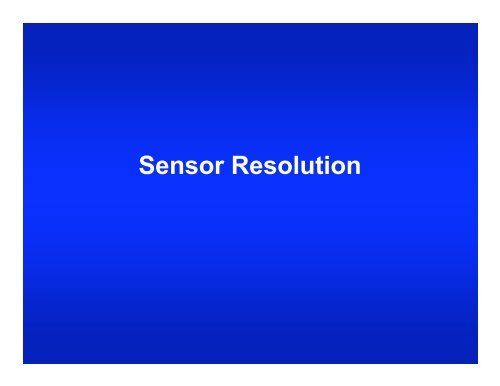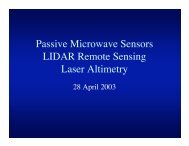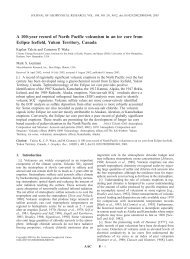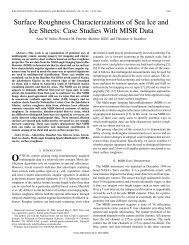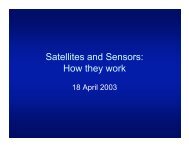Sensor Resolution
Sensor Resolution
Sensor Resolution
You also want an ePaper? Increase the reach of your titles
YUMPU automatically turns print PDFs into web optimized ePapers that Google loves.
<strong>Sensor</strong> <strong>Resolution</strong>
Outline for 4/14/2003<br />
• Digital imagery - follow-on from last lecture<br />
• Spatial <strong>Resolution</strong><br />
• Spectral <strong>Resolution</strong><br />
• Temporal<br />
• Radiometric<br />
• Instrument sensitivity
Digital Number<br />
at-sensor<br />
radiance<br />
imaging optics<br />
detectors<br />
electronics<br />
DN<br />
DN is proportional to at-sensor radiance
<strong>Resolution</strong> and Instrument<br />
Response Functions<br />
• <strong>Sensor</strong> has finite precision<br />
• Input signals vary in time and space<br />
• <strong>Sensor</strong> has “response function” (spatial,<br />
spectral)<br />
input<br />
signal<br />
output<br />
signal<br />
convolution<br />
w/response<br />
function
Spatial <strong>Resolution</strong><br />
• “A measure of the smallest angular or linear<br />
separation between two objects that can be<br />
resolved by the sensor”. (Jensen, 2000)<br />
• Resolving power is the ability to perceive two<br />
adjacent objects as being distinct<br />
– size<br />
– distance<br />
– shape<br />
– color<br />
– contrast characteristics<br />
– sensor characteristics
• Instantaneous field of view (IFOV) is the<br />
angular field of view of the sensor,<br />
independent of height<br />
• IFOV is a relative measure because it is an<br />
angle, not a length<br />
b
GIFOV<br />
• Ground-projected instantaneous field of view<br />
(GIFOV) depends on satellite height (H)<br />
Ê<br />
GIFOV = 2H tanÁ<br />
IFOV<br />
Ë 2<br />
ˆ<br />
˜<br />
¯
IKONOS image of Gunnison River Basin, CO<br />
1 kilometer<br />
1 meter resolution 250 meter resolution
Spectral <strong>Resolution</strong><br />
• The width and number of spectral intervals in<br />
the electromagnetic spectrum to which a<br />
remote sensing instrument is sensitive<br />
• Allows characterization based on geophysical<br />
parameters (chemistry, mineralogy,etc.)
Spectral <strong>Resolution</strong><br />
• Determined by:<br />
– the number of spectral bands<br />
– spectral response function of each band<br />
– full-width at half-maximum (FWHM)
AVIRIS image of Moffat Field, CA<br />
224 channels from 0.4 - 2.5 mm<br />
10 nm bandwidth
• Surface components with very distinct<br />
spectral differences can be resolved using<br />
broad wavelength ranges
Subtle differences require finer spectral resolution<br />
vegetation spectral signatures from Jasper Ridge
Radiometric <strong>Resolution</strong><br />
• Number of digital levels that a sensor can use<br />
to express variability of brightness within the<br />
data<br />
• Determines the information content of the<br />
image<br />
• The more levels, the more detail can be<br />
expressed
Radiometric <strong>Resolution</strong><br />
• Determined by the number of bits of<br />
within which the digital information is<br />
encoded<br />
2 2 = 4 levels<br />
2 8 = 256 levels<br />
2 12 = 4096 levels
2 bit radiometric resolution<br />
8 bit radiometric resolution
Dynamic<br />
Range<br />
Saturation<br />
Dark<br />
Current<br />
Signal<br />
Image Brightness<br />
Actual<br />
<strong>Sensor</strong><br />
Response<br />
Scene Brightness<br />
Ideal<br />
Response
Temporal <strong>Resolution</strong><br />
• The frequency of data acquisition over<br />
an area<br />
• Depend on:<br />
– the orbital parameters of the satellite<br />
– latitude of the target<br />
– swath width of the sensor<br />
– pointing ability of the sensor
• Multi-temporal imagery is important for<br />
– infrequent observational opportunities (e.g.,<br />
when clouds often obscure the surface)<br />
– short-lived phenomenon (floods, oil spills,<br />
etc.)<br />
– rapid-response (fires, hurricanes)<br />
– detecting changing properties of a feature to<br />
distinguish it from otherwise similar features
Breakup of the Larsen B Ice Shelf<br />
Courtesy of Ted Scambos, NSIDC<br />
MODIS<br />
imagery from<br />
January 31, 2002-<br />
March 6, 2002
Signal Strength<br />
• Depends on<br />
– Energy flux from the surface<br />
– Altitude of the sensor<br />
– Spectral bandwidth of the detector<br />
– IFOV<br />
– Dwell time
Signal-to-Noise Ratio (SNR)<br />
<strong>Sensor</strong> responds to a both target brightness<br />
(signal) and electronic errors from various<br />
sensor components (noise)<br />
SNR = signal to noise ratio<br />
signal<br />
noise<br />
signal = the actual energy reaching the detector<br />
noise = random error in the measurement (all<br />
systematic noise has been removed)<br />
†<br />
To be effective, sensor must have high SNR
Noise =<br />
n<br />
Â<br />
i=1<br />
( ) 2<br />
DN i<br />
- m DN<br />
n -1
Mean DN = 201<br />
Noise = 1.345<br />
SNR = 201/1.345 = 149<br />
50%<br />
200<br />
201<br />
199<br />
203<br />
202<br />
201<br />
200
Noise Equivalent Radiance or<br />
Reflectance<br />
• A measure of the lowest signal that can be<br />
detected just before the signal falls below the<br />
level of the noise<br />
NEDL or NEDr = the standard deviation<br />
of the Mean (of a set of measurements)<br />
that produces a SNR of 1


